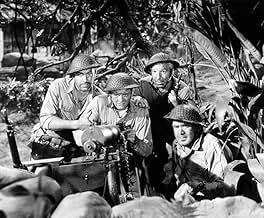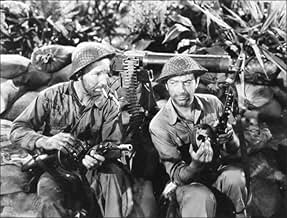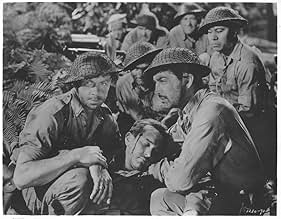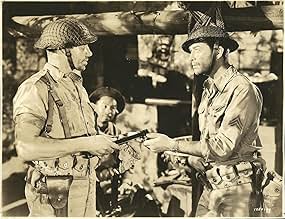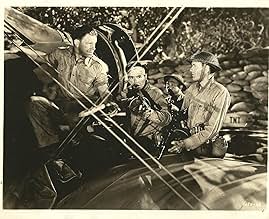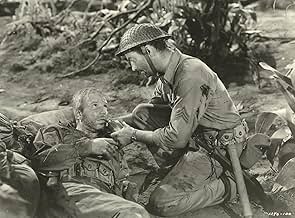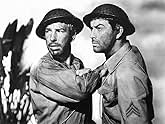IMDb RATING
6.9/10
2.9K
YOUR RATING
In 1942, in the Bataan peninsula of the Philippines, a ragtag American unit commanded by Sergeant Bill Dane attempts to blow-up a bridge in order to slow the Japanese advance.In 1942, in the Bataan peninsula of the Philippines, a ragtag American unit commanded by Sergeant Bill Dane attempts to blow-up a bridge in order to slow the Japanese advance.In 1942, in the Bataan peninsula of the Philippines, a ragtag American unit commanded by Sergeant Bill Dane attempts to blow-up a bridge in order to slow the Japanese advance.
- Director
- Writers
- Stars
- Awards
- 5 wins total
Alex Havier
- Yankee Salazar
- (as J. Alex Havier)
Ernie Alexander
- Wounded Soldier
- (uncredited)
Luke Chan
- Japanese Soldier
- (uncredited)
Wing Foo
- Japanese Soldier
- (uncredited)
Bud Geary
- Infantry Soldier
- (uncredited)
- Director
- Writers
- All cast & crew
- Production, box office & more at IMDbPro
Featured reviews
The film talks about the Pacific battle , during WWII , concerning the defenders of Bataan but Japan has just invaded . A small group of soldiers (Thomas Mitchell , LLoyd Nolan , Desi Arnaz , among others) flee from Japanese repeatedly attack and they head for blowing-up a bridge on the Bataan location and their final destination : Corregidor . The captain (Lee Bowman) dies and the top-sergeant (Robert Taylor) takes command along with an Airbone lieutenant (George Murphy). The military unit surrounded by the Japanese in a foggy set , lush jungle and progressively dwindling group . The defenders gave a few days for posterior victories and future US conquest like Midway , Island Salomon and Bismark . The Bataan of the film's title refers to both the World War II Battle of Bataan and the place Bataan which is a Central Luzon region province on Luzon island in the Philippines which occupies the whole of the Bataan Peninsula on the island . This movie's dedication states that it is dedicated to the heroes of Bataan.
This classic warlike movie is nicely starred by Robert Taylor at one of his best roles as a tough sergeant , he's accompanied by a plethora of first-rate secondaries . This exciting actioner warfare completed with slice of military stereotypes although some characters are very one-dimensional , as well as presenting an African American in an intelligent and sympathetic manner , attempting to avoid any racial speeches in the script . The original plot belongs to ¨Lost patrol¨ (1934) by John Ford , whose screenplay has been pretty imitated and remade many times but it's still a magnificent entertainment . In fact , Metro-Goldwyn-Mayer paid RKO a lot of money for the right to use scenes from Lost patrol in this movie . As ¨Lost patrol¨ was subsequently remade and reworked several times : ¨Sahara¨ (by Zoltan Korda) with scenarios in Libya desert ; ¨Last of Comanches¨ (Andre De Toth) in California desert ; and even part of ¨Flight of Phoenix¨ (Robert Aldrich) in Sahara desert , and , of course , this ¨Bataan¨(Tay Garnett) in Philippines jungle . This is one of a handful of feature films that have featured the story of the World War II Battle of Bataan , they include ¨So proudly we hail¡¨ by Mark Sandrich (1943) ; ¨They were expendable¨ (1945) by John Ford and ¨Back to Bataan¨ (1945) by Edward Dmytryck . The film is set into a lush , abundant jungle with a dense fog made by usual Metro Goldwin Mayer production designer , Cedric Gibbons , and it contains an atmospheric as well as thrilling musical score by Bronislau Kaper . The motion picture was professionally directed by Tay Garnett, a good Hollywood craftsman.
The actual deeds about Bataan concern an unsuccessful attempt by US and Filipino troops under General Douglas MacArthur to defend the peninsular against the Japanese 1 Jan-9 April 1942 . Following the surrender of Bataan , MacArthur was evacuated , but Allies captives were force-marched 95 km/60 mi to the nearest railhead in the Bataan Death March,ill-treatment by the Japanese guards during the march killed about 16.000 US and Filipino troops .
This classic warlike movie is nicely starred by Robert Taylor at one of his best roles as a tough sergeant , he's accompanied by a plethora of first-rate secondaries . This exciting actioner warfare completed with slice of military stereotypes although some characters are very one-dimensional , as well as presenting an African American in an intelligent and sympathetic manner , attempting to avoid any racial speeches in the script . The original plot belongs to ¨Lost patrol¨ (1934) by John Ford , whose screenplay has been pretty imitated and remade many times but it's still a magnificent entertainment . In fact , Metro-Goldwyn-Mayer paid RKO a lot of money for the right to use scenes from Lost patrol in this movie . As ¨Lost patrol¨ was subsequently remade and reworked several times : ¨Sahara¨ (by Zoltan Korda) with scenarios in Libya desert ; ¨Last of Comanches¨ (Andre De Toth) in California desert ; and even part of ¨Flight of Phoenix¨ (Robert Aldrich) in Sahara desert , and , of course , this ¨Bataan¨(Tay Garnett) in Philippines jungle . This is one of a handful of feature films that have featured the story of the World War II Battle of Bataan , they include ¨So proudly we hail¡¨ by Mark Sandrich (1943) ; ¨They were expendable¨ (1945) by John Ford and ¨Back to Bataan¨ (1945) by Edward Dmytryck . The film is set into a lush , abundant jungle with a dense fog made by usual Metro Goldwin Mayer production designer , Cedric Gibbons , and it contains an atmospheric as well as thrilling musical score by Bronislau Kaper . The motion picture was professionally directed by Tay Garnett, a good Hollywood craftsman.
The actual deeds about Bataan concern an unsuccessful attempt by US and Filipino troops under General Douglas MacArthur to defend the peninsular against the Japanese 1 Jan-9 April 1942 . Following the surrender of Bataan , MacArthur was evacuated , but Allies captives were force-marched 95 km/60 mi to the nearest railhead in the Bataan Death March,ill-treatment by the Japanese guards during the march killed about 16.000 US and Filipino troops .
I remember seeing this film as a child, but only recently did I get a copy of the DVD and experience it as an adult. Being a student of history and in the military, war films have to go a long way to impress me. This one doesn't let you down. In some ways I think it does a better job realistically portraying war than some modern films I've seen. This small patrol of US Army soldiers must contend with lethal sniper fire, air raids, and overwhelming numbers of Japanese soldiers. One other thing it does a good job at is fully representing the diverse social spectrum of our country. For a film made in 1943, that is quite an accomplishment. Bravo!
World War II and it's the Bataan peninsula. 13 members of the US armed forces, with Filipino volunteers, have been hastily assembled to blow up a bridge and delay Japanese attempts to rebuild it for as long as possible. As the Japanese close in from the surrounding jungle, the men must also battle with their own wills to have any hope of survival.
Lets get the complaints of others out the way first. Yes this is a studio shot production, yes there is model work involved, and yes this is unashamedly a flag waving, chest thumping, rally call of heroism. Based around actual events, this is a fictionalised telling that also has no shame in being disparaging towards the Japanese in the film. Now are these things really a problem? This is after all 1943, a time when the US was struggling in the Pacific conflict. A loose copy of John Ford's 1934 film The Lost Patrol, Bataan served as a moral booster for the public back home. The message is clear, this may be tantamount to a suicide mission, because, well, war is indeed hell, but sacrifices are necessary to achieve the bigger freedom objective.
Nicely directed by Tay Garnett {The Postman Always Rings Twice} and tightly scripted by Robert Hardy Andrews {The Cross of Lorraine}, the film stars Robert Taylor, George Murphy, Thomas Mitchell, Robert Walker, Desi Arnaz & Lloyd Nolan. Violent and brutal for its time {the hand to hand bayonet sequences are brilliantly realised}, Bataan is also notable for portraying a racially integrated fighting force having to come together for the greater good. This group of men are a mixed bunch, different backgrounds, different races and different classes. But they are in the same boat as the Japanese start to pick them off one by one, and not only that, but Malaria is in the camp as well. The tension is racked up, the atmosphere stifling, we the viewers are witness to a unique show of heroism as we live with these men during their last soul sapping days.
The cast do really well when one considers they are in fact playing disposable characters. Taylor in particular is effective as the tough Sergeant forced into command of the group. While some scenes such as a moodily staged camouflaged Japanese approach are truly memorable and linger long in the memory. The end also is terrific, one which puts one in mind of Sam Peckinpah watching and nodding approvingly. High on suspense and beating a real brave heart, Bataan is up with the best that the war genre of film has to offer. Belyng its budget restrictions it achieves its aims and then some. 8.5/10
Lets get the complaints of others out the way first. Yes this is a studio shot production, yes there is model work involved, and yes this is unashamedly a flag waving, chest thumping, rally call of heroism. Based around actual events, this is a fictionalised telling that also has no shame in being disparaging towards the Japanese in the film. Now are these things really a problem? This is after all 1943, a time when the US was struggling in the Pacific conflict. A loose copy of John Ford's 1934 film The Lost Patrol, Bataan served as a moral booster for the public back home. The message is clear, this may be tantamount to a suicide mission, because, well, war is indeed hell, but sacrifices are necessary to achieve the bigger freedom objective.
Nicely directed by Tay Garnett {The Postman Always Rings Twice} and tightly scripted by Robert Hardy Andrews {The Cross of Lorraine}, the film stars Robert Taylor, George Murphy, Thomas Mitchell, Robert Walker, Desi Arnaz & Lloyd Nolan. Violent and brutal for its time {the hand to hand bayonet sequences are brilliantly realised}, Bataan is also notable for portraying a racially integrated fighting force having to come together for the greater good. This group of men are a mixed bunch, different backgrounds, different races and different classes. But they are in the same boat as the Japanese start to pick them off one by one, and not only that, but Malaria is in the camp as well. The tension is racked up, the atmosphere stifling, we the viewers are witness to a unique show of heroism as we live with these men during their last soul sapping days.
The cast do really well when one considers they are in fact playing disposable characters. Taylor in particular is effective as the tough Sergeant forced into command of the group. While some scenes such as a moodily staged camouflaged Japanese approach are truly memorable and linger long in the memory. The end also is terrific, one which puts one in mind of Sam Peckinpah watching and nodding approvingly. High on suspense and beating a real brave heart, Bataan is up with the best that the war genre of film has to offer. Belyng its budget restrictions it achieves its aims and then some. 8.5/10
BATAAN is one of the better war films to come out during the war years of World War II. Robert Taylor holds the whole gritty film together with his realistic depiction of a sergeant leading a small troop of men in an effort to hold back the Japanese attack by blowing up a crucial bridge. Taylor, Robert Walker as a gum-chewing homesick sailor, Lloyd Nolan, Dezi Arnaz (surprisingly effective in a dramatic role) and others make splendid contributions. Special mention should be made of Philip Terry's medic--an under-appreciated actor who is shown as committed to his job in a selfless way but finally going berserk under the pressures of war. (He had other good roles in Olivia de Havilland's TO EACH HIS OWN and Ray Milland's THE LOST WEEKEND).
The jungle setting (although filmed on the studio lot) is impressive with its exotic foliage and adds to the realism. The hand to hand combat scenes are well staged, as are the final moments of the film.
All in all, a gripping war film that more than holds its own with contemporary stories like SAVING PRIVATE RYAN.
Has to be appreciated in the context of its time--when flag-waving patriotism was at its peak and lines like "Those dirty Japs" were not considered politically incorrect.
The jungle setting (although filmed on the studio lot) is impressive with its exotic foliage and adds to the realism. The hand to hand combat scenes are well staged, as are the final moments of the film.
All in all, a gripping war film that more than holds its own with contemporary stories like SAVING PRIVATE RYAN.
Has to be appreciated in the context of its time--when flag-waving patriotism was at its peak and lines like "Those dirty Japs" were not considered politically incorrect.
Bataan is a province, central Luzon, Philippines, sheltering Manila Bay from the South China Sea... It is largely covered by jungle and is traversed north to south by steep mountains...
After the Japanese invasion of the Philippines in December 1941 and the fall of Manila (January 2, 1942), the defending Americans and Filipinos withdrew to Bataan, foiling Japanese efforts to split the forces of U.S. General Douglas MacArthur... His troops fought a fierce delaying action until April 9, 1942, and remnants, led by Lieut. Gen. Jonathan M.Wainwright, escaped to Corregidor Island, where they surrendered about a month later...
On January 9, 1945, U.S. Forces, under MacArthur, landed at Lingayen Gulf to the north and sealed off the Bataan Peninsula... Landings were then made at Mariveles Harbor in the south and on Corregidor Island, thus securing Manila Bay for the U.S. Navy...
"Bataan" is the fictional story of 13 men who stayed behind, holding a bridge, and fighting to the death a rear guard action to ensure the success of the Allied forces retreat from the Philippines...
The audience live with the soldiers their last heroic days: George Murphy, an Air Force Lieutenant secretly reliable; Lloyd Nolan, the smart Corporal with compassionate qualities; Thomas Mitchell, a career NCO; Deni Arnaz, a friendly Spanish soldier; Barry Nelson, the competent Matowski; Lee Bowman, the Captain who falls with a bullet; Robert Walker (in his screen debut) who almost breaks down from homesickness; Kenneth Spencer, the black soldier with an undisturbed force and simple dignity, and Robert Taylor, the tough heroic Sergeant alive in the face of the enemy, who sets up his machine gun and keeps it firing until the end...
All are representatives of the heroism existing in all Americans, symbol of the heroic resistance...
After the Japanese invasion of the Philippines in December 1941 and the fall of Manila (January 2, 1942), the defending Americans and Filipinos withdrew to Bataan, foiling Japanese efforts to split the forces of U.S. General Douglas MacArthur... His troops fought a fierce delaying action until April 9, 1942, and remnants, led by Lieut. Gen. Jonathan M.Wainwright, escaped to Corregidor Island, where they surrendered about a month later...
On January 9, 1945, U.S. Forces, under MacArthur, landed at Lingayen Gulf to the north and sealed off the Bataan Peninsula... Landings were then made at Mariveles Harbor in the south and on Corregidor Island, thus securing Manila Bay for the U.S. Navy...
"Bataan" is the fictional story of 13 men who stayed behind, holding a bridge, and fighting to the death a rear guard action to ensure the success of the Allied forces retreat from the Philippines...
The audience live with the soldiers their last heroic days: George Murphy, an Air Force Lieutenant secretly reliable; Lloyd Nolan, the smart Corporal with compassionate qualities; Thomas Mitchell, a career NCO; Deni Arnaz, a friendly Spanish soldier; Barry Nelson, the competent Matowski; Lee Bowman, the Captain who falls with a bullet; Robert Walker (in his screen debut) who almost breaks down from homesickness; Kenneth Spencer, the black soldier with an undisturbed force and simple dignity, and Robert Taylor, the tough heroic Sergeant alive in the face of the enemy, who sets up his machine gun and keeps it firing until the end...
All are representatives of the heroism existing in all Americans, symbol of the heroic resistance...
Did you know
- TriviaPrologue: "When Japan struck, our desperate need was time--time to Marshall our new armies. Ninety-six priceless days were bought for us--with their lives--by the defenders of Bataan, the Philippine army which formed the bulk of MacArthur's infantry fighting shoulder to shoulder with Americans. To those immortal dead, who heroically stayed stayed the wave of barbaric conquest, this picture is reverently dedicated."
- GoofsAlthough the American soldier was clearly a great coconut tree climber, it is near to impossible to sit atop a coconut tree. Many Filipinos to this day fall when attempting this.
- Quotes
Sergeant Bill Dane: Come on, suckers! What's the matter with you? What are you waitin' for? Didn't think we were here, did you? You dirty rotten rats! We're still here! We'll always be here! Why don't you come and get it?
- Crazy creditsClosing credits epilogue: So fought the heroes of Bataan. Their sacrifice made possible our victories in the Coral and Bismark Seas, at Midway, on New Guinea and Guadalcanal. Their spirit will lead us back to Bataan!
- Alternate versionsAlso available in a computer colorized version.
- ConnectionsFeatured in Toast of the Town: A Salute to Lucy and Desi (1954)
- SoundtracksSt. Louis Blues
(1914) (uncredited)
Music and Lyrics by W.C. Handy
Sung a cappella and hummed often by Kenneth Spencer
- How long is Bataan?Powered by Alexa
Details
Box office
- Budget
- $958,000 (estimated)
- Runtime
- 1h 54m(114 min)
- Color
- Aspect ratio
- 1.37 : 1
Contribute to this page
Suggest an edit or add missing content


